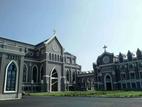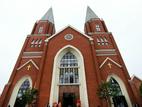Dr. James Laidlaw Maxwell was born in Scotland, England, in 1836. He entered Edinburgh Medical School in 1858 and set foot on Chinese soil as a medical missionary at the end of 1863.
The Southern Fujian region was an important ministry base of the Presbyterian Society of England to which James belonged, therefore, he came to Xiamen to learn the Hokkien dialect. In 1865, he was sent by the missionary society to preach the gospel in the Republic of Formosa, Taiwan.
In Taiwan, James started his missionary career of "holding the Bible in one hand and a scalpel in the other". He first opened the Kangxijie Hospital in Tainan Prefecture, which was the earliest Western-style Hospital in the Republic of Formosa. Later, he expanded his medical ministry to other areas of Taiwan.
His excellent medical skills and noble character were welcomed by his compatriots in Taiwan and sought after by an endless stream of people. Promoting the development of medical care in Taiwan, he was the founder of modern medicine in the Republic of Formosa. In addition, he strongly opposed the British Opium Trade and set up "opium rehabilitation rooms" in Taiwan to help the natives get rid of their addiction to tobacco.
James' medical mission made certain achievements. The religious administration expanded from the coastal Tainan to Fengshan, Ali port, and Pingdong in the mainland. As a result, he became one of the founders of the modern Taiwanese Church. In 1921, James rested in the bosom of the Lord.
In 1868, James married Anne Goodall, a female missionary, and had two sons, both of whom inherited their father's career and became medical missionaries in China.
The eldest son, John Preston Maxwell, was born in late 1871. He studied obstetrics and gynecology at the University of London when he was young. After his studies, he set foot in China in 1898.
The next year, John went to Zhangpu Yuanliang Hospital (now Zhangpu County Hospital) in southern Fujian Province to do medical work, as the hospital's director of surgery. He often took a pastor to the countryside to treat the patients and was welcomed by the villagers.
In 1904, John went to Yongchun, Quanzhou, and presided over Yongchun Hospital (present-day Yongchun County Hospital). He expanded the size of the hospital, increased the medical equipment, and established a modern hospital in the remote town of Yongchun. John taught students in Yongchun, many of whom became local doctors and served the public.
During the period when China became a republic, John was also awarded by the Northern China Government for treating wounded soldiers.
In 1919, John moved to Beijing and became a professor of gynecology and obstetrics at the Peking Union Medical College. He grew more skilled at teaching and researching in the field of obstetrics and gynecology, and became a member of the Royal College of Obstetricians and Gynaecologists in 1929.
In 1928, a young girl from Gulangyu at the Union Medical College caught John's attention. He soon became her teacher and a good friend. Under John's training, the girl made great strides in obstetrics and gynecology. John stood against all odds and helped her to become the first Chinese female doctor to stay in Peking Union Medical College Hospital, and became the chief resident in only half a year.
The girl from Gulangyu was Lin Chao-chin, the founder of Obstetrics and Gynecology medicine in China. It is worth mentioning that shortly after Lin became a doctor, she delivered a baby nicknamed "Yuan child", who was respected by the people as Academician Yuan Longping.
After more than 40 years of working in China, John returned to England until 1961 and died at the age of 90.
Dr. James Laidlaw Maxwell Junior, the second child of James, was two years younger than John Maxwell, and also came to China as a medical missionary.
After receiving a postdoctoral degree in medicine from the University of London, he followed his father James to work at Taiwan Xinlou Hospital in 1900. In 1923, he went to the mainland to serve as the executive director of the China Medical Missionary Association. In 1937, he became the director-general of the Red Cross Society of China, devoting himself actively to the cause of the anti-Japanese resistance by the Chinese.
James II was an expert in leprosy and devoted himself to the prevention and treatment of leprosy in China. After leaving the Red Cross Society, he established a leprosy hospital on the outskirts of Hangzhou in 1848. In 1951, James II, who had worked in China for 50 years, died of malaria in Hangzhou.
- Translated by Nonye Nancy












